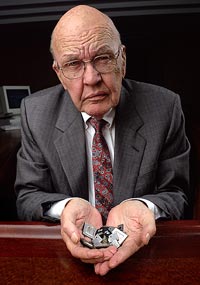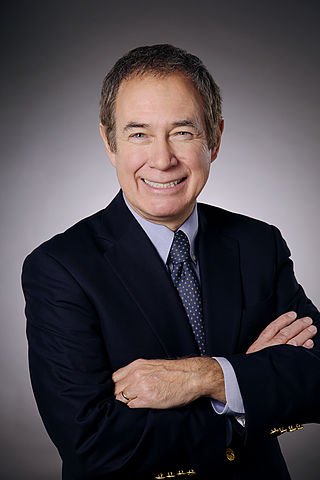
Sir Charles Kao Kuen was a Chinese physicist and Nobel laureate who contributed to the development and use of fiber optics in telecommunications. In the 1960s, Kao created various methods to combine glass fibers with lasers in order to transmit digital data, which laid the groundwork for the evolution of the Internet.

Jack St. Clair Kilby was an American electrical engineer who took part, along with Robert Noyce of Fairchild Semiconductor, in the realization of the first integrated circuit while working at Texas Instruments (TI) in 1958. He was awarded the Nobel Prize in Physics on 10 December 2000.

An optical fiber, or optical fibre, is a flexible glass or plastic fiber that can transmit light from one end to the other. Such fibers find wide usage in fiber-optic communications, where they permit transmission over longer distances and at higher bandwidths than electrical cables. Fibers are used instead of metal wires because signals travel along them with less loss and are immune to electromagnetic interference. Fibers are also used for illumination and imaging, and are often wrapped in bundles so they may be used to carry light into, or images out of confined spaces, as in the case of a fiberscope. Specially designed fibers are also used for a variety of other applications, such as fiber optic sensors and fiber lasers.
William Ralph Bennett Jr. was an American physicist known for his pioneering work on gas lasers. He spent most of his career on the faculty of Yale University.
Peter C. Schultz is an American academic who is co-inventor of the fiber optics used for telecommunications. He is retired President of Heraeus Tenevo Inc., a technical glass manufacturer specializing in fiber optics and semiconductor markets, and retired Chief Technical Officer North America for Heraeus Holding GmbH. In 2001, he was elected as a member into the National Academy of Engineering for invention and development of manufacturing methods and glass compositions for low-attenuation glass fibers for optical communication.
John Burnette MacChesney II was an American scientist. A Bell Labs pioneer in optical communication, he was best known for his 1974 invention of the modified chemical vapor deposition (MCVD) process with colleague P.B. O'Connor, and for co-inventing high-purity "sol-gel" overcladding for optical fiber in the early 1980s. These inventions were key to the commercial manufacture of optical fiber.
The John Tyndall Award is given to the "individual who has made pioneering, highly significant, or continuing technical or leadership contributions to fiber optics technology". The award is named after John Tyndall (1820-1893), who demonstrated for the first time internal reflection.
Stewart David Personick is an American researcher in telecommunications and computer networking. He worked at Bell Labs, TRW, and Bellcore, researching optical fiber receiver design, propagation in multi-mode optical fibers, time-domain reflectometry, and the end-to-end modeling of fiber-optic communication systems.
Charles Stuart Ballantine was an American electronic engineer and inventor.
Stewart E. Miller was a noted American pioneer in microwave and optical communications.

Charles H. Henry was an American physicist. He was born in Chicago, Illinois. He received an M.S. degree in physics in 1959 from the University of Chicago, and a Ph.D. degree in physics in 1965 from the University of Illinois, under the direction of Charlie Slichter. In March 2008, he was featured in an article in the Physics Illinois News, a publication of the Physics Department of the University of Illinois.
Donald B. Keck is an American research physicist and engineer most noted for his involvement in developing low-loss optical fiber. Keck grew up in Lansing, Michigan and attended Michigan State University, after which he joined Corning Incorporated’s research department. As a senior research scientist for Corning, Keck, along with Robert D. Maurer and Peter C. Schultz, designed the first optical fiber with optical losses low enough for wide use in telecommunications.
Rod C. Alferness was president of The Optical Society in 2008.
G. Michael Morris was president of the Optical Society of America in 2002.

Kenneth O. Hill is a Mexican Canadian physicist who specializes in the field of photonics. In the late 1970s, he discovered the phenomena of photosensitivity in optical fiber and has worked extensively in its applications. He first demonstrated Fiber Bragg gratings and their applications in optical communication and optical sensor systems. Further areas of his discovery and innovation include the phase mask technique for grating fabrication, fiber grating dispersion compensators, and wavelength selective fiber filters, multiplexers and demultiplexers. This field of research has led to the ability to create high speed fiber optic networks as well as many other communication applications that have revolutionized the telecommunications industry.

Benjamin John Eggleton,, is Pro Vice Chancellor (Research) at the University of Sydney. He is also Professor in the School of Physics where he leads a research group in integrated photonics, nonlinear optics and smart sensors and serves as co-director of the NSW Smart Sensing Network (NSSN).

Paul R. Prucnal is an American electrical engineer. He is a professor of electrical engineering at Princeton University. He is best known for his seminal work in Neuromorphic Photonics, optical code division multiple access (OCDMA) and the invention of the terahertz optical asymmetric demultiplexor (TOAD). He is currently a fellow of IEEE for contributions to photonic switching and fiber-optic networks, Optical Society of America and National Academy of Inventors.
David F. Welch is an American businessman and research scientist. Welch is a pioneer in the field of optical devices and optical transport systems for telecommunications networks. Welch first made it possible to commercially deploy reliable 980 nm laser pumps, needed in low noise optical amplifiers employed in dense wavelength division multiplexing (DWDM) telecommunications systems. He also achieved the first commercial optoelectronics integrated circuit, several years ahead of any competing research or developments laboratory.
Kazuro Kikuchi is a professor in the Department of Electrical Engineering and Information Systems at the University of Tokyo and a long-time researcher on fiber-optic communications.

John E. Bowers is an American physicist, engineer, researcher and educator. He holds the Fred Kavli Chair in Nanotechnology, the director of the Institute for Energy Efficiency and a distinguished professor in the Departments of Electrical and Computer Engineering and Materials at University of California, Santa Barbara. He was the deputy director of American Institute of Manufacturing of Integrated Photonics from 2015 to 2022.







